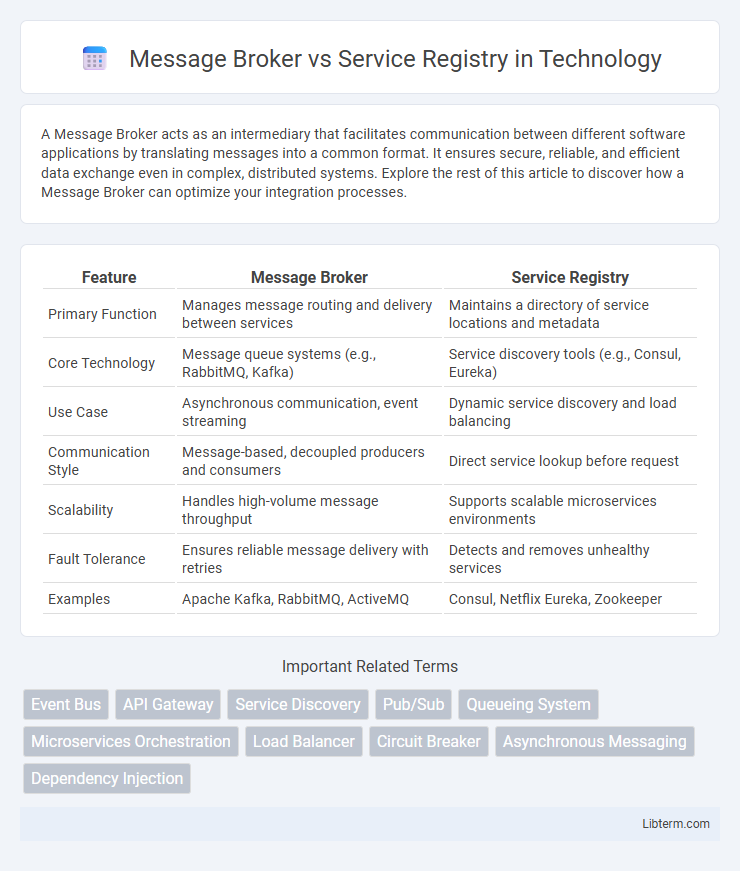A Message Broker acts as an intermediary that facilitates communication between different software applications by translating messages into a common format. It ensures secure, reliable, and efficient data exchange even in complex, distributed systems. Explore the rest of this article to discover how a Message Broker can optimize your integration processes.
Table of Comparison
| Feature | Message Broker | Service Registry |
|---|---|---|
| Primary Function | Manages message routing and delivery between services | Maintains a directory of service locations and metadata |
| Core Technology | Message queue systems (e.g., RabbitMQ, Kafka) | Service discovery tools (e.g., Consul, Eureka) |
| Use Case | Asynchronous communication, event streaming | Dynamic service discovery and load balancing |
| Communication Style | Message-based, decoupled producers and consumers | Direct service lookup before request |
| Scalability | Handles high-volume message throughput | Supports scalable microservices environments |
| Fault Tolerance | Ensures reliable message delivery with retries | Detects and removes unhealthy services |
| Examples | Apache Kafka, RabbitMQ, ActiveMQ | Consul, Netflix Eureka, Zookeeper |
Introduction to Message Brokers and Service Registries
Message brokers facilitate communication between distributed services by routing, transforming, and managing messages to ensure reliable and asynchronous data exchange. Service registries maintain a dynamic directory of service instances, enabling efficient service discovery and load balancing in microservices architectures. Both components play pivotal roles in enhancing scalability, fault tolerance, and operational efficiency in modern distributed systems.
Defining Message Brokers: Core Concepts
Message brokers serve as intermediaries that facilitate communication between distributed systems by routing, transforming, and delivering messages across diverse applications and services. They decouple producers and consumers, improving scalability, reliability, and asynchronous messaging through core features like message queuing, topic-based pub/sub, and protocol translation. Key examples include Apache Kafka, RabbitMQ, and ActiveMQ, which support event-driven architectures and microservices integration.
Understanding Service Registries: Key Functions
Service registries maintain a dynamic database of available microservices, enabling efficient service discovery by storing metadata such as service endpoints, health status, and version information. They play a critical role in load balancing and fault tolerance by continuously updating service availability and enabling clients to locate the optimal instance for communication. Unlike message brokers that handle message routing and asynchronous communication, service registries focus on real-time service metadata management and seamless integration within distributed systems.
Architectural Roles in Distributed Systems
Message brokers facilitate asynchronous communication between distributed services by routing, transforming, and queuing messages to ensure reliable data exchange and decoupling of service components. Service registries maintain a dynamic catalog of available services and their network locations, enabling service discovery and load balancing by allowing clients to locate and interact with active service instances. Together, message brokers handle message flow and integration patterns, while service registries provide critical metadata and connectivity information essential for resilient and scalable microservices architecture.
Communication Patterns: Messaging vs Discovery
Message brokers facilitate asynchronous communication by enabling message queuing and routing between distributed services, supporting patterns like publish-subscribe and point-to-point messaging. Service registries enable dynamic service discovery by maintaining up-to-date metadata about available service instances, allowing clients to locate and connect to services in real-time. While message brokers optimize data exchange through robust messaging protocols, service registries optimize connectivity by providing centralized service endpoint information for efficient invocation.
Scalability and Performance Considerations
Message brokers enhance scalability by decoupling services and enabling asynchronous communication, which reduces system bottlenecks and allows for efficient load distribution across multiple consumers. Service registries support scalability by dynamically managing service instances and enabling clients to discover and balance loads among available services, minimizing downtime and improving response times in distributed systems. While message brokers excel in handling high-throughput, event-driven architectures, service registries optimize direct service-to-service interactions, making the choice dependent on specific performance requirements and architectural design.
Fault Tolerance and Reliability
Message brokers enhance fault tolerance and reliability by ensuring message persistence, delivery guarantees, and enabling asynchronous communication between distributed services, which prevents data loss during failures. Service registries contribute by maintaining updated service instance information, facilitating dynamic service discovery and load balancing to avoid single points of failure. Combining message brokers with service registries results in robust microservices architectures that support failover mechanisms and resilient inter-service communication.
Use Cases: When to Use Message Brokers
Message brokers are ideal for asynchronous communication, decoupling services, and handling high-throughput event streaming in microservices architectures. Use cases include real-time data processing, event-driven workflows, and reliable message delivery across distributed systems. Unlike service registries that manage service discovery and health monitoring, message brokers excel in scenarios requiring message queuing, routing, and transformation.
Use Cases: When to Use Service Registries
Service registries are essential in microservices architectures for enabling dynamic service discovery, particularly in environments with frequently changing service instances. They are used when services need to locate and communicate with each other efficiently without hardcoding network locations, enhancing scalability and fault tolerance. Common use cases include dynamic load balancing, failover management, and real-time service monitoring in cloud-native applications.
Choosing the Right Solution for Your System
Selecting the right solution between a message broker and a service registry depends on your system's communication patterns and scalability needs. Message brokers like Apache Kafka or RabbitMQ efficiently handle asynchronous, event-driven messaging to decouple services and improve fault tolerance. Service registries such as Consul or Eureka enable dynamic service discovery and load balancing, essential for microservices architectures requiring real-time location tracking of available services.
Message Broker Infographic

 libterm.com
libterm.com